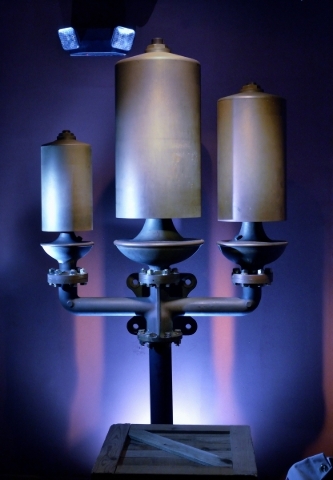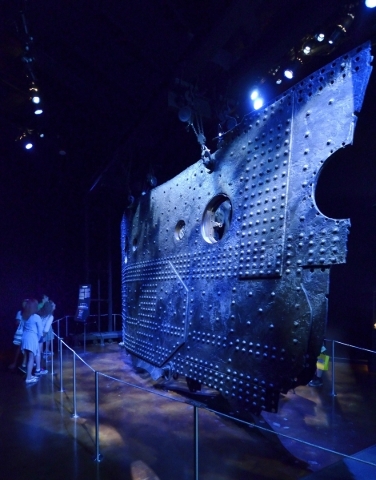Whistles give voice to tragedy at Luxor Titanic exhibition
They seem mournful, like ships' whistles sometimes can be, but it's probably not fair to blame the whistles for that.
Blame it, instead, on listeners' knowledge of the story behind the whistles, which helps to make their sound something more than just the sum of the notes.
Starting Sept. 1, visitors to "Titanic: The Artifact Exhibition" at Luxor have been hearing a unique bit of Titanic history: The actual sound of the ocean liner's whistles incorporated into the audio background of the exhibition, which tells the story of the ill-fated RMS Titanic's maiden voyage more than a century ago.
By now, the basics are just about universally known: The New York City-bound Titanic leaves Southampton, England, on April 10, 1912 and on April 14 strikes an iceberg a few hundred miles south of Newfoundland, Canada. When the Titanic sinks two hours and 40 minutes later, more than 1,500 of the 2,220-plus people on board are lost.
In the more than 100 years since the tragedy, the sinking of the Titanic has become more than a mere historical event. It is iconic in popular culture, ubiquitous in entertainment — including in Las Vegas, where the sinking of the Titanic has been a segment in "Jubilee!" for decades — and common as a metaphor for human hubris.
"Titanic: The Artifact Exhibition" features items — from papers, luggage and kitchenware to a large section of the ship's hull — recovered from the site of the wreck. It's in the early portion of the exhibition, in the construction hallway, where guests can hear the actual sound of the ship's whistles.
It's the same sound, or close to it, that Titanic's passengers would have heard in the harbor as the ship set out on its first and only voyage, and the sound passengers would have heard at noon each day while at sea. The inclusion of the whistle sound — two separate blasts lasting about eight seconds each — in the exhibition marks the 30th anniversary of the discovery of the ship's wreck site.
"One of the important reasons for having this sound recording is because it actually gives the ship Titanic a voice, which we've never been able to do before," explains Alexandra Klingelhofer, vice president of collections for Premier Exhibitions Inc., the exhibition's producer.
"I think that's one of the senses that's hard to connect with when you're going through the exhibit: What did it sound like? You can imagine the coldness of an iceberg or the clatter of dishes, but the actual sound of the ship, that is something that is very difficult to bring into your consciousness when you go through an exhibit."
A set of Titanic whistles was recovered from the ocean's bottom in 1993. That set is on display in Buena Park, Calif., while visitors to the Las Vegas exhibition can view a replica set of whistles created from those originals.
It is believed that the recovered whistle set, made up of three differently tuned bronze cylinders, was mounted on the first funnel of the Titanic. After the whistles were raised to the surface, they were X-rayed and inspected and eventually determined able to produce one last sound one more time.
So, in 1999, high-pressured air — steam would have been used on the Titanic — was directed through the three whistles, and the whistle tones that were recorded now can be heard in the Las Vegas exhibition.
Klingelhofer says that part of the inspection process focused on ensuring that the whistles still could produce a sound that was "as close as possible" to the sound the whistles would have made originally. And while there are no recordings of the whistles produced with steam in their heyday, "this comes pretty close," she says.
Also unknown for certain is whether the whistles sounded as the Titanic sank. Typically, whistles were used "to move around the harbor," Klingelhofer says, with different signals denoting different actions.
That the whistles were found and recovered is amazing enough, Klingelhofer says. But being able to sound the whistles once more to hear the tones created on board the Titanic more than a century ago?
That, she says, is like "doing a music history and suddenly coming across an unheard-of recording from some great blues singer in the '20s who's never been heard before and suddenly hearing it. It's the same emotion. And it might be scratchy but it's still the original voice. And, now, the Titanic has one, too."
Klingelhofer says she felt "chills" when she first heard it. "You could almost imagine yourself back there in Southampton or one of the other ports and think about the great adventure, about to start on the maiden voyage."
Now, 100-plus years later and equipped with knowledge of what would come, hearing the original whistles can evoke an odd mix of intellectual excitement about an aural artifact and deep emotion at knowing what happened to those who heard it firsthand long ago.
"But that's also good," Klingelhofer says, "because the story is an emotional one and always kind of reflects back on ourselves."
Contact reporter John Przybys at jprzybys@reviewjournal.com or 702-383-0280 or follow @JJPrzybys on Twitter.

































